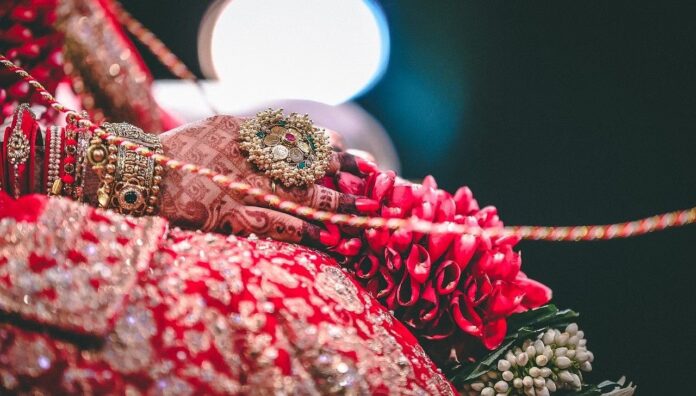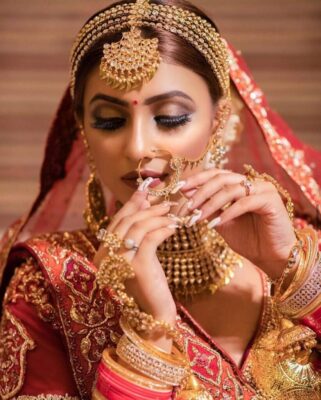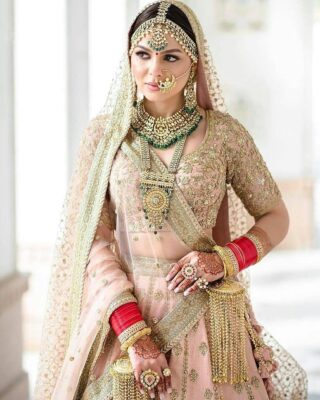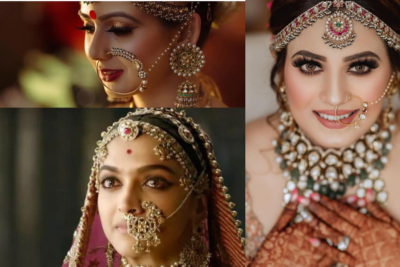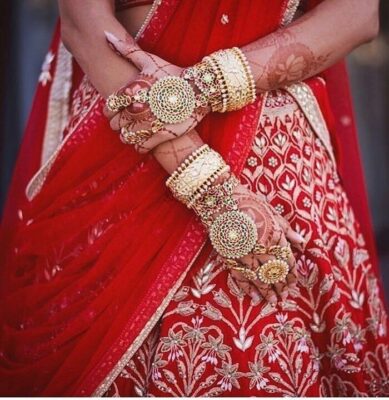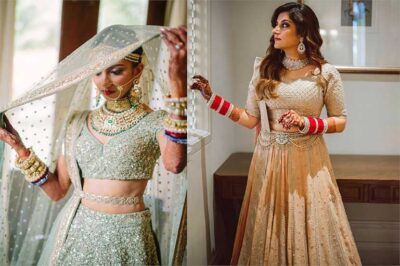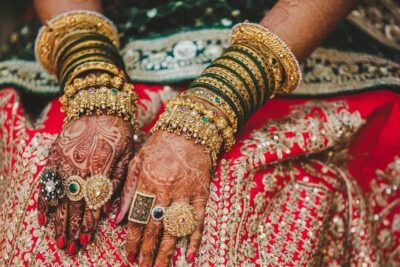Accessorizing the entire wedding party, including bridesmaids, groomsmen and family members is an essential aspect of wedding planning. When it comes to Indian weddings, jewellery plays an important role in adding elegance and cultural significance to the festivities. Here are some stylish choices for the entire wedding party.
For The Bride
Maang Tikka
The Maang Tikka, worn by women, serves as a forehead ornament symbolizing femininity, marital status, and cultural identity. Its origins can be traced back to ancient traditions where it represented the third eye, believed to enhance intuition and wisdom, before evolving into a bridal adornment. From traditional Kundan and Polki styles to modern designs featuring pearls and diamonds, Maang Tikkas showcase a diverse range of craftsmanship and symbolism. Integral to the bridal attire, the Maang Tikka adds the finishing touch, representing the bride’s elegance and beauty.
Necklace (Rani Haar)
Rani Haar, as the name suggests, is a neckpiece for the queens. It typically features multiple layers of intricately crafted Kundan work, where gemstones are set in gold or silver foil to create a vibrant and intricate mosaic. They are long, majestic neckpieces that turn eyes and heads alike. As opposed to a necklace, a Rani Haar is significantly longer and regal, having various layers and a pendant. These haars are often studded with rubies, emeralds or even diamonds and pearls and are irresistibly gorgeous and have a royal touch to them. The Rani Haar is a bold and standalone piece of jewellery, and no Indian bride should miss a chance to don this regal chain of perfection on her big day.
Earrings (Jhumkas)
The Jhumka, characterized by its unique bell-shaped design, brings fluidity and movement, accompanied by a delicate jingling sound with every head turn. Throughout history, Jhumka earrings have maintained their revered status in India, Pakistan, and Bangladesh as sought-after accessories. They remain an enduring style of ethnic jewellery, perpetually embraced by fashion trends. What makes Jhumka earrings particularly captivating is the variety of styles available, each incorporating the bell shape in its distinctive manner. Serving as a statement piece, these earrings instantly elevate the glamour of any outfit.
Nath (nose ring)
The Nath is considered a symbol of marriage and is an essential part of the bridal ensemble. It represents the honour and prosperity of the bride and is believed to bring good luck to the couple’s married life. Nath nose rings come in various designs and styles, reflecting the diversity of Indian culture. The most popular style is the Nathni which is a large hoop or ring that is worn on the left nostril. It is often adorned with precious stones, pearls, or intricate gold work. Nath nose rings are typically made of gold or silver. Gold Nath is the most popular choice for brides as it signifies wealth and prosperity. However, silver Nath with an oxidised or antique finish is also favoured by some brides for its rustic and traditional appeal. The Nath is usually attached to the bride’s hair or draped over the ear with the help of a chain or hook. This adds an elegant touch to the overall bridal look.
Hath Phool (Hand Jewellery)
Hath Phool, also known as hand flowers or hand harness, is a traditional piece of jewellery worn on the hands by Indian brides. It is a beautiful and intricate accessory that adds elegance to the bridal ensemble. Hath Phool consists of a decorative chain or bracelet that extends from the wrist to the fingers. It typically features intricate designs and is adorned with gemstones, beads, pearls, or meenakari (enamel work). The chain is connected to rings or individual loops that are worn on the fingers. It is believed to enhance the beauty of the bride’s hands and is considered a symbol of femininity and auspiciousness. It is also believed to bring good fortune and happiness to the newlywed couple. There are various types of hath Phool designs available:
Single Chain: A simple and delicate design with a single chain connected to a ring or loop worn on the finger.
Multiple Chains: Hath Phool with multiple chains, creating a more elaborate and intricate look. Each chain is connected to a ring or loop on a different finger.
Floral Design: Hath Phool features floral motifs, with chains resembling flower petals and rings representing the centre of the flower. Kundan or Polki Hath Phool: These styles feature Kundan or Polki gemstones set in gold or silver, creating a regal and luxurious look.
Hath Phool is a stunning and intricate accessory that adds grace and charm to the bride’s hands, complementing her overall bridal attire.
Kamarbandh (Waist Chain)
Kamarbandh, also known as a waist chain or belly chain, is a traditional Indian jewellery piece worn around the waist. It is often crafted with intricate designs, featuring elements such as beads, gemstones, pearls, or filigree work. It can be made from various materials, including gold, silver, or other metals. Gold Kamarbandhs are highly popular for their luxurious and traditional appeal. Silver kamarbandhs with intricate designs or oxidized finish are also favoured for their elegant and vintage look. Additionally, kamarbandhs can be adorned with gemstones, pearls, or enamel work, depending on the desired style. The chain is adjustable to fit different waist sizes, and it may have a hook or clasp for secure fastening. It accentuates the waistline of the bride and adds a touch of glamour to her ensemble. It is considered a symbol of femininity and beauty and is believed to enhance the bride’s grace and posture.
Bridal anklets
Bridal anklets, also known as payal or pahjeb, are traditional jewellery pieces worn around the ankles by brides at Indian weddings. They are delicate and charming accessories that accentuate the bride’s feet and add a touch of elegance to her overall bridal look. The anklets are typically made of silver, gold, or a combination of both. They feature intricate designs, often incorporating elements such as beads, bells, charms, gemstones, or meenakari. They may also be adorned with small dangling ornaments or ghungroos (tiny bells) that produce a pleasant tinkling sound as the bride walks. They are believed to enhance the bride’s femininity and grace, while also symbolizing marital bliss and good fortune. The tinkling sound produced by the anklets is considered auspicious and is believed to ward off any negative energy. Bridal anklets are exquisite accessories that add a delightful touch to the bride’s feet and overall bridal ensemble.
In Indian weddings, jewellery not only enhances the aesthetic appeal but also carries cultural significance, making each piece a cherished part of the celebration. When choosing jewellery for the bride, consider the colours, styles, and cultural elements that resonate with the overall theme of the wedding.





